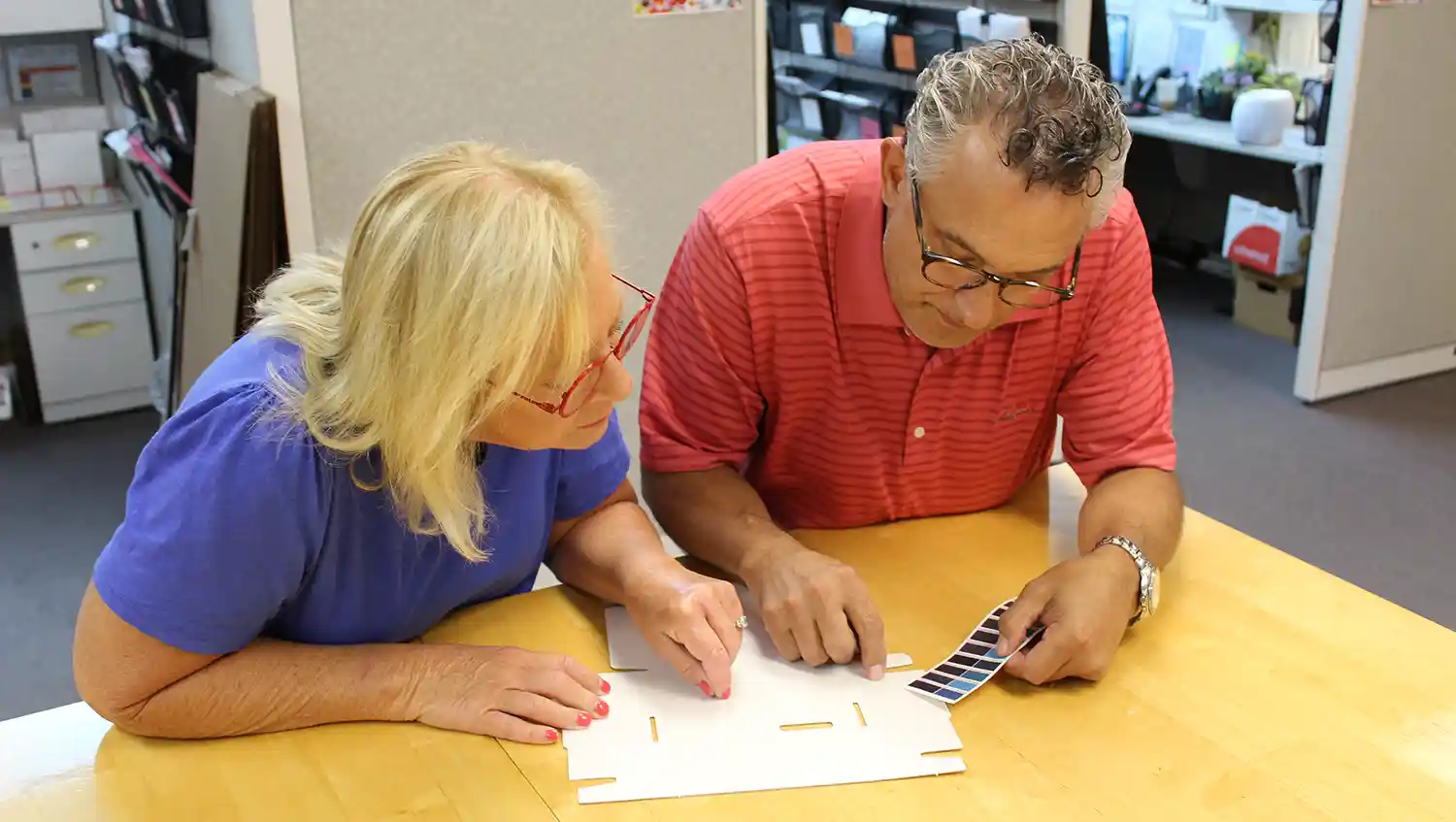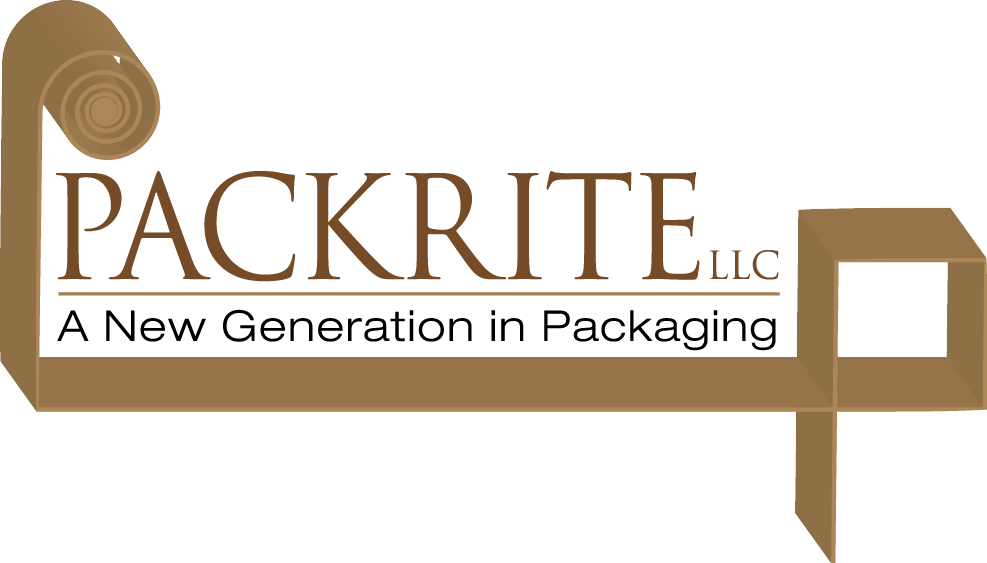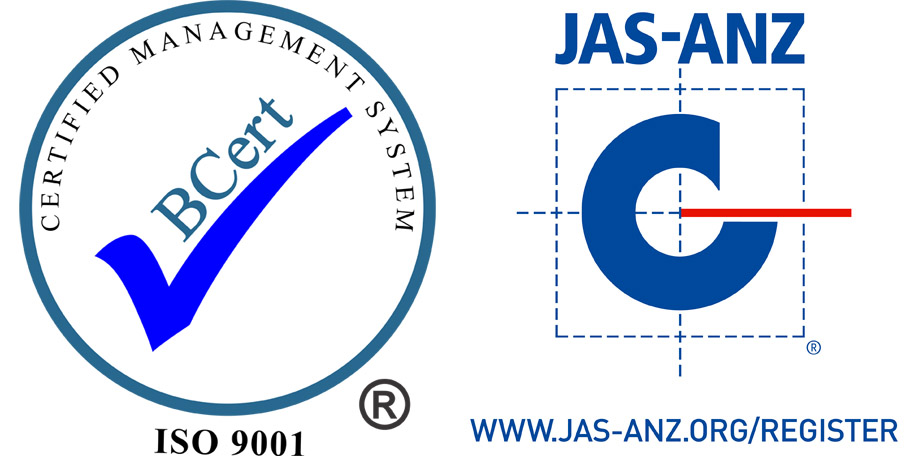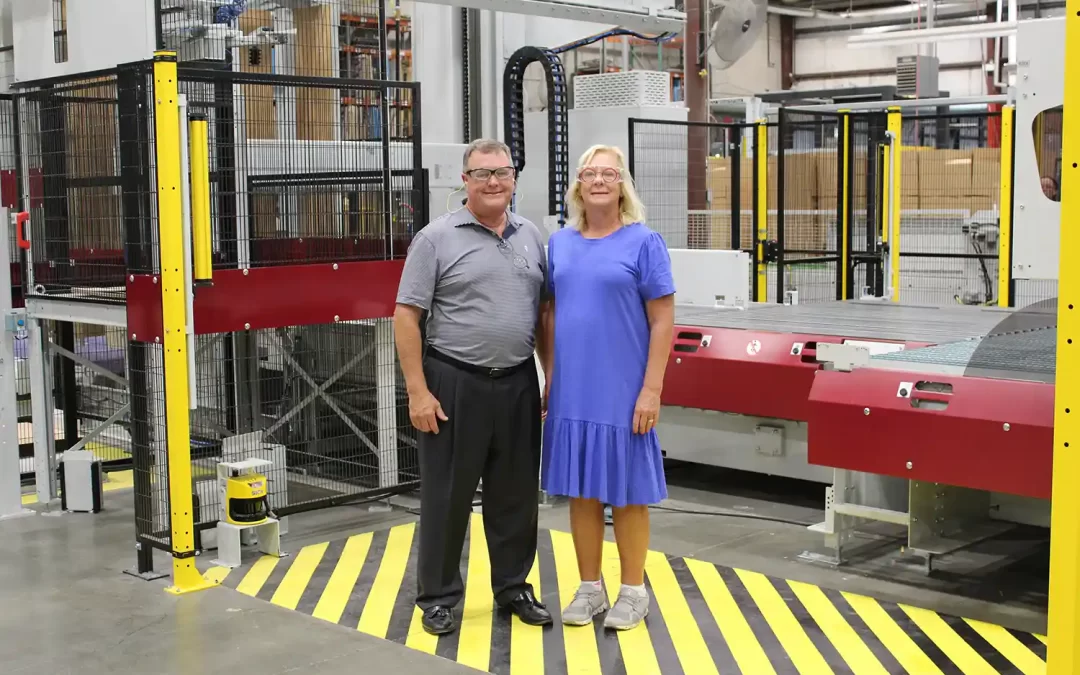Cover image: Michael and Mary Drummond pose by the Bobst Palletizer 2.1.
Packrite: Newest Investment Offers Precision With Added Punch
Packrite LLC’s latest equipment installation continues the company’s longtime partnership with Bobst, adding a Bobst Breaker Flat Track nick breaker and palletizer to its lineup of the Swiss company’s precision converting machinery and ancillary material-handling equipment. Packrite completed the project in July, and the new investments continue Packrite’s trajectory of upward growth, according to CEO Michael Drummond. “The nick breaker and load former represent an investment of another $1.5 million,” he says. “We keep progressing and growing.”
Packrite, located in High Point, North Carolina, was founded in 2007 by Michael and Mary Drummond. Michael’s pedigree is in the folding carton business, having been a part owner with his father of Preferred Packaging, also in High Point.
As Michael tells it, with the continued evolution of microflute profiles in the early 2000s—E, F, and proprietary profiles such as G and N—Preferred Packaging’s mix of business was changing. “We were doing a lot of microflute packaging for other corrugated companies across the United States,” he explains. “They didn’t know how to handle N flute and some of the real micros, plus very complex folds and foil stamping and things that they did not want to play in and we were doing.”
Preferred’s principal suppliers of the microflute at the time were Alliance Packaging (now WestRock) in Winston- Salem, North Carolina, and Flutes LLC (part of the Schwarz Group) in Indianapolis. “That’s where we started— utilizing them to form flute for us,” Michael says.
As successful as Preferred Packaging was, time intervened: The company was sold to allow the elder Drummond to retire. “My father and I were in that business together,” Michael explains. “He was the majority stockholder, and he said, ‘Do you want to buy it?’ It was nothing but older equipment, and that wasn’t my philosophy. My father liked buying older equipment and building it up; I like buying new equipment and growing.”
So Michael, with his native expertise in the complexities of folding carton convert- ing, decided to start his own business. “I chose to venture out on my own and put my money where my mouth was,” he says. “So, we went out and borrowed $8 million out of the gate.”
To Michael, the equipment choices in those startup years were simple: Acquire capacity for forming microflute corrugated, the precision die cutting necessary to con- vert it, and the folding and gluing capability to deliver a flawless box to the customer. “We started with one Asitrade; one die cutter and a folder gluer and went out to the marketplace and said, ‘Hey, we’re here!’ ”
The year was 2008—just before the Great Recession—but as Michael remembers it, the timing was fortunate for him and Packrite. “The downturn actually ended up being really good for me because I had gotten all my loans established,” he says. “I had gotten the company up and going, and I didn’t have any competition coming into my marketplace because the chance of borrow- ing that kind of money again for a startup company or someone seeking an expansion was slim [to] none after that point.”
Geography also played to the new company’s advantage, since Packrite’s newly installed Bobst Expertflute 64″ x 67″ Asitrade Singleface-Laminator was one of the few in that part of the country that sold to the trade. Thus, Packrite’s influx of business in those early years was primarily from other boxmakers, both corrugated and folding carton. “At the time, we were the only other Asitrade in the southeast United States and the only one for the trade,” Michael explains. “The closest one was in Indianapolis.”
The Expertflute installation provided Packrite with the in-house capability to produce B, E, F, and N flutes. “We bought one new piece of equipment, and I was just amazed at how much business it brought us very quickly,” says Michael.
Recalling the advantages he brought to his converting industry customers, he says, “What we did for them right out of the gate was to allow them to expand their own graphic footprint. We started with F, E, and B, and soon after that, we ended up adding N flute for a number of our customers in Chicago who were in the folding carton industry and had to have N flute.”
Michael structured Packrite from the start to cross both segments of the paperboard market. “When we started out, the size and print to cut registration were the critical factors,” he says. “So we started with a 57″ x 41″ die cutter and a 51″ gluer. That was big for folding carton, small for corrugated. We glued things that boggled the minds of corrugated companies and also handled the oversized jobs the folding carton people couldn’t handle. We were right in the middle and feeding off both.”
Michael’s market instincts validated his early investments. Asked why, with his years of expertise in the folding carton industry, he did not pursue that route, he explains, “There are plenty of print assets out there. There are tons of good printers, but those printers are very specific to, ‘OK, you’ve got eight colors, and it’s 40 inches or six colors and 64 inches, or seven-color 81- or 73-inch, and each one of those assets is millions and millions of dollars. And if you buy one, you’ve got to sell to that one.’ I bought the converting equipment that takes whichever press is the best fit.”
Michael describes Packrite’s converting process as “print agnostic.” Since the company possesses no printing capability of its own, it can accommodate any print process commonly used in corrugated and folding carton packaging, from litho offset roll-to-roll preprint and flexo preprint to gravure and digital. With this kind of print diversity, Packrite has become synonymous with quality, preci- sion laminating, die cutting, and gluing. Marketplace demand for this precision continues to grow for consumer brands, e-commerce packaging, and retail and point-of-purchase applications, and the
company has responded in kind. Michael points to a specific example of a two-sided print display package, with preprinted litho offset roll on the inside of the box and a preprinted litho sheet laminated to it. Pointing to the accuracy of the print-to-cut registration, he says, “We can hold plus or minus one-thirty-second of an inch on the outside graphics and one-eighth of an inch on the print to cut registration on the inside.”
Packrite’s precision equipment menu has been artfully crafted from the beginning. The initial investments were the Bobst Expertflute Asitrade 67; a Bobst 145 Expertcut 57″ x 41″; and a Bobst 130 Masterfold specialty folder-gluer. According to Michael, the Expertcut die cutter was the first one in the world set up as a “crossover,” giving Packrite the flexibility in converting either microflute corrugated or folding carton substrates. “Bobst was going to upgrade it after three years to all the latest and greatest technology based on our experience, but they changed so much that they replaced it with a brand-new machine; so, this is my second 145,” he says.
Michael explains that his business grew so fast in the early years that he ran out of gluing capacity. “In 2011, we added a sec- ond gluer, the 170 Masterfold,” he recalls. “When I add something, I just don’t add the same thing; I expand our capabilities.”
The Masterfold, Michael says, can pro- duce what he called a “double gyro box” in a process that rotates the blank in process to create complex specialty folded items. “The Masterfold,” he says, “can create a double gyro box, which means it can take a blank, fold it in several directions, turning it 90 degrees or even 180 degrees.”
Saying this technology is more commonly found in folding carton companies, he adds, “Still today we’re the only corrugated double gyro in the country.” He says the machine also has the capability
to apply double-sided tape, tear tape, and reinforcing tape, and to insert literature.
Michael notes that Packrite has been on a fairly consistent schedule of adding new equipment every two to three years as its business grew. True to schedule, the addi- tion of the 170 Masterfold soon strained the capacity of the 145 Expertcut, so a second die cutter was acquired in 2013,
a Bobst 2.1 Mastercut 83″ x 52″. “I call it my beast,” he says. “It has automatic
infeed, and she just eats and eats and eats.”

Mary Drummond and Mark Karow, Packrite sales for Southeast, examine a folding carton project at the company’s headquarters in High Point, North Carolina.
In 2015, Packrite began planning an expansion project that would add 60,000 square feet to its manufacturing footprint, bringing the total to 200,000. The object of the project was the addition, in 2016, of a second Asitrade, the Bobst Asitrade 81, 64″ x 81″. The new machine has a capacity of 12,000 sheets per hour and adds new C, B, E, and F flute capability. Michael points out that the Asitrade 81 has been outfitted with Copar conditioning units to allow it to pretreat liners with added heat and moisture, giving Packrite added flexibility to run both heavy and lighter-weight grades. Packrite cut the ribbon on the new addition and Asitrade in an open house in February 2017, which was attended by more than 400 box- makers, suppliers, and end-use customers.
With more microflute capacity, Packrite was again faced with a bottleneck, this time in its gluing lines. Enter the Bobst 230 Expertfold, acquired in 2022. The 230 Expertfold adds more capability for straight-line, auto-bottom, and four-corner and six-corner trays.
The Bobst Breaker Flat Track, the most recent addition to Packrite’s precision con- verting lines, was installed this summer on the back of the 2.1 Mastercut die cutter. The unit allows a single-pass break in both directions, a conveyor offset for safe and easy quality control checks and sample removal, and a fully automatic palletizer with automatic squaring, bottom-sheet, and pallet insertion. According to Michael, the Bobst Breaker will substantially increase the uptime of the 2.1 Mastercut. “When jobs come off the back of the 2.1, the operators have to pick it up, break it apart, and then take it over and stack it on a skid,” he says. “Well, when you’re doing a lot of short runs, that’s pretty efficient. But when you’re getting into some of the larger runs that we do with the Asitrade, it slows the die cutter down substantially.”
Michael says he didn’t add the unit initially when he acquired the 2.1 Mastercut because Bobst had not perfected the machine’s design to handle nested cartons. “The Bobst Breaker Flat Track does away with manual breaking, but I did not do this at first because we do a lot of nesting like a folding carton company, and Bobst couldn’t handle that,” he says. “Now with [the] new design they came out with a couple years ago, we can nest cartons without any problem.”
Michael’s real fascination with the technology, however, is its ability to auto- matically palletize. “The thing that made the Bobst Breaker important for me is that I can run an 80-some-inch sheet, eight up, break it apart, and then the machine will reshuffle it and put it onto a skid. There’s no tow motor or three people on the back,” he says. “You’ve got a machine that’s running and not restricted by people. The blanks can then go directly to the folder-gluers.”
The labor-saving feature of the Bobst Breaker Flat Track has allowed Michael to reassign workers otherwise occupied with breaking and stacking die cuts on skids. This, he says, is a real advantage during a time when good workers are hard to find and retain in manufacturing and converting plants. “The Breaker has not only given me additional capacity, [but it also] allows me to redeploy people into other departments,” he explains. “To me, this was labor avoidance— not that I wanted less labor. I wanted more labor to continue to grow. Labor’s hard to find, and if I could redeploy that labor into the gluing department and the die cutting department, that was a huge deal for me.”
In a virtual tour of the company, produced for AICC’s Southeast Summit held in Greensboro, North Carolina, in March 2021, Michael called Packrite LLC “the premier trade finisher for fluted high- graphic packaging.” The company is ISO 9001-certified, and with Michael and Mary as the majority stockholders, Packrite qual- ifies as a woman-owned business as defined by the Women’s Business Enterprise National Council. Michael also credits his involvement in AICC with helping the company’s growth, saying, “I was late to the game with AICC, but for me personally, it helped me join a corrugated CEO group and understand the market better.”
Michael and Mary consider Packrite to be a “boutique” boxmaker. “We make what everybody else doesn’t want to make,” says Michael. And with their latest investment, the Drummonds have ensured the company’s unique market position for the years ahead.
Article first appeared in BoxScore Magazine November/December 2023 issue by Steve Young
Steve Young is AICC’s ambassador-at-large.
He can be reached at 202-297-0583 or syoung@AICCbox.org.


